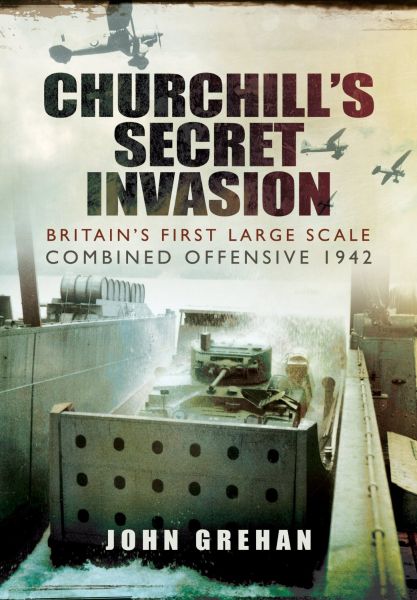| Title: | Churchill`s Secret Invasion |
| Subtitle: | Britain`s first large-scale combined operations offensive 1942 |
| Writer: | John Grehan |
| Publisher: | Pen & Sword Military |
| Published: | 2013 |
| Pages: | 212 |
| Language: | English |
| ISBN: | 9781781593820 |
| Review: |
"Churchill’s Secret Invasion" deals with the British Operations Ironclad and Streamline Jane, both of which targeted the conquest of the French colony of Madagascar. The book is written by British author, editor and historian John Grehan (Whitworth, 1951). Madagascar was very strategically located for the British because all convoys from South Africa that were bound for the Middle East and British India and back had to pass this island. The position of Madagascar itself was such that the large island dominated the entire western Indian Ocean. The British feared that the Japanese would take over control from the Vichy French in order to use the bases for their submarines. Recently the Eastern Fleet had retreated to Mombasa, Kenya, because it feared an invasion of Ceylon. The Vichy French government collaborated with the Germans. Japanese submarines operating from Madagascar would severely hinder the lines of communication with Ceylon and British India. The Americans gave the green light for the British operation because Madagascar had large amounts of graphite at its disposal, which was important for the development of the atom bomb. In the spring of 1942, Churchill ordered the operation to conquer Madagascar. In order to keep the operation secret, even the free French, who were led by General De Gaulle, were not informed about the planned invasion of the island. The island was defended by a force of 9,000 men consisting of French, Senegalese and native soldiers. On May, 5th, 1942, a force of 13,000 British troops landed near the northernmost harbour of Madagascar, Diego Suarez. In two days the British force, supported by a fleet of several aircraft carriers, cruisers, destroyers, cargo ships and the venerable battle ship HMS Ramillies, had conquered the strategically important harbour and its vicinity. The SAAF (South African Air Force) supported Operation Ironclad by flying many reconnaissance sorties. The second phase of the conquest of Madagascar, under the code name Streamline Jane, started on September 10th of 1942 and ended on November 8th of that year with the French capitulation and the entire remainder of the island came under British control. This operation was conducted by British, Kenyan, Tanzanian, Rhodesian and South African troops. The landing craft and troop transport ships were protected, next to the Royal Navy, by the Dutch cruiser Hr.Ms. Jacob van Heemskerck and the Dutch destroyers Hr.Ms. van Galen and Hr.Ms. Tjerk Hiddes. Despite the fact that the British conquest of Madagascar didn’t receive a lot of attention in the literature of the Second World War, it was a most important and radical event with far reaching consequences. It was the largest British amphibious assault since the Dardanelles in Turkey in 1915 during the Great War and it was the first allied invasion across the sea in which combined forces were used: navy, army and air force. The experience gained here would be used at all further allied landings during the rest of the Second World War. This was mainly the deployment of special marine commandos, specially adapted vehicles and Landing Ships Tanks or LST’s. In addition to this the British learned that it was preferable to conquer enemy airfields ,instead of destroying them, and put them to use. Besides, the British discovered that it was essential to train the combined forces at least for six months before such a vast and complicated operation could be embarked upon. Not much later this was painfully demonstrated by the failed landing of the Canadians at Dieppe. This was Operation Jubilee, the repelled invasion at Dieppe conducted mainly by Canadian troops in August, 1942, only four months after operation Ironclad. Operation Torch, the invasion by the British and Americans of North Africa that took place in November, 1942, was successful though. The conquest of Madagascar was a significant operation because it demanded important troops , landing ships and ships that were actually required for the British battle against the Japanese in Burma and British India. Also the British eastern Fleet was heavily burdened by the operation because for months on a row war ships were needed to escort and protect the invasion force. The most important consequence from the British invasion of Madagascar found itself however in a political framework. Through the execution of Operation Catapult, the partial destruction and confiscation of the French Navy by the Royal Navy in July, 1940, the relation between the former allies Great Britain and France had already cooled down quite significantly. The fact that the(Free) French were once again left out of the decision making process on the occupation of Madagascar left them feeling betrayed ,deceived and moved sideways again. Until far after World War Two France would choose its own course in its defences and would not be bothered too much by NATO interests, although until March, 1966, they were part of the organisation. Apart from that, the French would develop their own nuclear program and policy. France even blocked British membership of the European Community until De Gaulle’s death in 1970. The British invasion of Madagascar is described very well by John Grehan as he also doesn’t omit war atrocities . The thing that makes "Churchill’s Secret War " extra interesting is the fact that the author brings the political and military backgrounds and their consequences clearly together. In this way Grehan shows not only that he has a lot of knowledge about the invasion itself but that he is also able to position the event in the complicated time frame of the forties of last century. Furthermore the book accentuates the bravery and innovative force of the British combined Armed Forces without getting chauvinistic or prejudiced. The author also makes clear that 1942 was a very important war year and that the allies at the time of Operation Ironclad were still very far from certainty about an eventual victory. It was in 1942 that very important turning points in World War Two took place, from the Battle of Midway and the blunting of Hitler’s summer offensive and subsequent encirclement of his sixth army in Stalingrad to the defeat of the Afrika Korps at El Alamein and the long American recapture of Guadalcanal. |
| Beoordeling: | |
Information
- Translated by:
- Peter ter Haar
- Article by:
- Peter Kimenai
- Published on:
- 09-03-2014
- Feedback?
- Send it!




